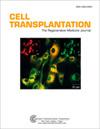From the Clinical to the Bench: Exploring the Insulin Modulation Effects of Tacrolimus and Belatacept
IF 3.2
4区 医学
Q3 CELL & TISSUE ENGINEERING
引用次数: 0
Abstract
Calcineurin inhibitors (CNIs) are critical in preventing rejection posttransplantation but pose an increased risk of post-transplant diabetes (PTD). Recent studies show that late conversion from CNIs to belatacept, a costimulation blocker, improves HbA1c in kidney transplant recipients with PTD or de novo diabetes. This study investigates whether the observed effects on PTD stem solely from CNI withdrawal or if belatacept influences PTD independently. The study assessed the impact of tacrolimus and belatacept on insulin secretion in MIN6 cells (a beta cell line) and rat islets. Tacrolimus and belatacept were administered to the cells and islets, followed by assessments of cell viability and insulin secretion. Tacrolimus impaired insulin secretion without affecting cell viability, while belatacept showed no detrimental effects on either parameter. These findings support clinical observations of improved HbA1c upon switching from tacrolimus to belatacept. Belatacept holds promise in islet or pancreas transplantation, particularly in patients with unstable diabetes. Successful cases of islet transplantation treated with belatacept without severe hypoglycemia highlight its potential in managing PTD. Further research is needed to fully understand the metabolic changes accompanying the transition from CNIs to belatacept. Preserving insulin secretion emerges as a promising avenue for investigation in this context.从临床到实验台:探索他克莫司和贝拉他赛普的胰岛素调节效应
降钙素抑制剂(CNIs)是预防移植后排斥反应的关键,但会增加移植后糖尿病(PTD)的风险。最近的研究表明,在患有 PTD 或新发糖尿病的肾移植受者中,晚期从 CNIs 转用成本刺激阻断剂贝拉替塞能改善 HbA1c。本研究探讨了所观察到的对 PTD 的影响是否仅源于停用 CNI,还是贝拉他赛普对 PTD 有独立影响。该研究评估了他克莫司和贝拉他赛普对 MIN6 细胞(β 细胞系)和大鼠胰岛分泌胰岛素的影响。给细胞和胰岛注射他克莫司和贝拉替塞,然后评估细胞活力和胰岛素分泌。他克莫司会损害胰岛素分泌,但不会影响细胞活力,而贝拉替塞对这两项参数都没有不利影响。这些发现支持了从他克莫司改用贝拉西普后 HbA1c 改善的临床观察结果。贝拉西普有望用于胰岛或胰腺移植,尤其是不稳定型糖尿病患者。贝拉他赛普治疗胰岛移植的成功病例没有出现严重的低血糖,这凸显了贝拉他赛普治疗 PTD 的潜力。要全面了解从 CNIs 过渡到贝拉西普的代谢变化,还需要进一步的研究。在这种情况下,保持胰岛素分泌是一个很有前景的研究方向。
本文章由计算机程序翻译,如有差异,请以英文原文为准。
求助全文
约1分钟内获得全文
求助全文
来源期刊

Cell Transplantation
生物-细胞与组织工程
CiteScore
6.00
自引率
3.00%
发文量
97
审稿时长
6 months
期刊介绍:
Cell Transplantation, The Regenerative Medicine Journal is an open access, peer reviewed journal that is published 12 times annually. Cell Transplantation is a multi-disciplinary forum for publication of articles on cell transplantation and its applications to human diseases. Articles focus on a myriad of topics including the physiological, medical, pre-clinical, tissue engineering, stem cell, and device-oriented aspects of the nervous, endocrine, cardiovascular, and endothelial systems, as well as genetically engineered cells. Cell Transplantation also reports on relevant technological advances, clinical studies, and regulatory considerations related to the implantation of cells into the body in order to provide complete coverage of the field.
 求助内容:
求助内容: 应助结果提醒方式:
应助结果提醒方式:


